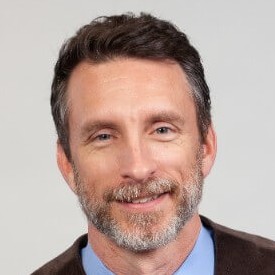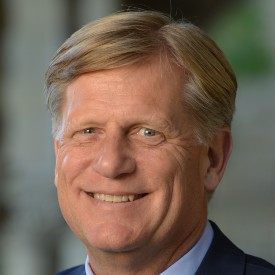Mike Michalowicz is a bestselling author, entrepreneur and speaker. He has built two additional multimillion-dollar companies and has become a keynote speaker on small-business topics.
Below, Mike shares five key insights from his new book, All In: How Great Leaders Build Unstoppable Teams. Listen to the audio version—read by Mike himself—in the Next Big Idea App.

1. A leader’s goal is to match individuals’ talents to tasks, not titles.
Most business owners and leaders try to fill roles or titles they have with talent. But the reality is if people are given the opportunity to do what they’re best at, they will excel. Additionally, they will excel not only confined neatly within one title but within titles, subcategories, or tasks. If we match up people’s talent to those individual tasks, you’ll find they morph outside the traditional pyramid structure of a title-oriented organization and flow into a more web-like structure.
I hired an individual to work for my organization as our CFO. He had certain talents that were perfect for that role, but not all of his talents were necessary. Sure enough, after a few months, it was clear he couldn’t fill that role, and I had made a big mistake. I was calling him the CFO, and he saw opportunities to work for other organizations as CFO and pointed out how woeful his salary was compared to what he deserved to earn. While I tried to point out that he didn’t have certain talents that we needed, he was confined to this title and ultimately left our organization.
We tried a different strategy. For our receptionist role, we needed someone who could greet walk-ins and answer the phone while also doing some data entry and light accounting. Our salesperson had to close opportunities, farm opportunities, and track data. In our CRM, we found that our salesperson was great at closing and data tracking but not so good at the farming component. We noticed our receptionist was great at greeting customers and building these really organic, healthy relationships with our prospects, but was not good at the data entry. We blurred the titles and matched the task to talent. We found that the person filling the receptionist role was best at doing the farming task and also for greeting customers coming in the door. Our salesperson, who was great at the data, took over some of the invoicing and the light accounting, and the other data entry. Both people flourished because they were doing what they were talented at, matching talent to task.
2. Everyone has a potential, they simply need to be put in the right role to exploit that potential.
What if instead of only 10 percent of the population being A players, everyone was? My research concluded that this was exactly the case. Everyone has a potential. They simply need to be put in the right role to exploit that potential. Admittedly, it may not be at your organization, but everyone has a fit somewhere. Our job is to find that potential.
Most organizations vet out on experiential ability, like what you see on a resume. Some vet on innate ability through Enneagrams or the Myers-Brigg Predictive Index. But very few look at potential ability and what someone can become.
“Everyone has a potential. They simply need to be put in the right role to exploit that potential.”
You can do this by running workshops. You may be familiar with Home Depot, and maybe you’ve heard of their birdhouse workshops where you can go with some family members to build a birdhouse. During that process, they’re simply watching people’s participation because potential always reveals itself in the same three stages. First, they show curiosity, then genuine interest, then desire. The Home Depot employee running the Birdhouse workshop is watching to see the most engaged people. They then tap them on the shoulder and offer them a job at Home Depot.
This is a concept that’s been around forever. The sports industry is already exploiting this near trillion-dollar industry. We have an opportunity as business leaders to deploy it. Professional and college sports recruit their athletes through workshops and camps. You go to a camp to improve your skills. As you improve your skills, they’re observing who is participating the most and who has the most desire and thirst. Then they tap you on the shoulder and invite you to other fields where you can demonstrate new talents and learn more. Then, ultimately, they can pick the people who are the best fit for them.
The beauty of the workshop is that everyone gets better and everyone improves in the process. Everyone now knows how to make a birdhouse from the Home Depot workshop. Everyone that went on the field got better at the sport and the best people, the best fitted people for the organization had the opportunity to work for that organization.
I interviewed Jewel, a retired University of Chicago Medical Center recruitment director. She ran workstations to evaluate people’s skills and abilities. Specifically, they had candidates who were interviewed in the traditional process. They’re asked questions, and based on their answers, they’re prioritized. In this case, they also ran those same candidates through skill assessment workstations. One station that was managed by Jewel herself was specifically for the process of checking in a new patient. Jewel emulated someone with cerebral palsy—she was familiar with the symptoms of cerebral palsy because her roommate had it; tiny motor skills are difficult, and something as simple as taking out your identification could take a full minute. What Jewel found is that some of the candidates were abrupt and curt. One person ripped the ID out of her hand and did it for her. While other candidates showed patience in offering assistance, the candidates who were best in the skills assessment were not necessarily the people who were best in the interview. The dominant person crushed the interview but failed to cater to the customer’s needs. The person who was qualified as the number one candidate in traditional interviews did not perform the best in the skills assessment. Through the skills assessment, where people demonstrated their abilities, the right people were selected. Sure enough, the University of Chicago Medical Center had its best recruitment ever. By running workshops, you can do the same.
3. Great leaders provide a safe environment for all levels.
We all have a need for physical safety, financial security, and emotional security. Great leaders provide a safe environment for all levels. There’s the story of the Ghost Girls. These women worked in a factory that made watches for soldiers in World War I. They used a material called radium. If you remember, old watches had dots on the dials that would glow in the dark. That was because of radium. These women would take a paintbrush, dip it in radium, and drop droplets on the watch, but then they’d use their mouth and lips to pinpoint the brush. In a matter of time, these women started to glow, hence the name Ghost Girls. Their skin would, in fact, glow. Soon after, a tumor or other ailments started to appear. The radium dial company back in the 1920s denied any culpability and said this wasn’t hazardous. This case is what ultimately created OSHA, the Occupational Safety and Health Association. With the unfortunate suffering of so many workers at that plant, it became apparent that workspaces had to be safe.
“Great leaders lead with humanness, with realness.”
In modern times, it’s clear we need to have physical safety. But I didn’t even know that my own organization didn’t have it. Through an anonymous survey, I asked my colleagues how safe they felt around our environment at the office. Multiple people answered that the alleyway that leads to the parking lot was pitch black at night. When leaving the office, people felt uncomfortable walking down the alleyway. What I realized as a leader of our team was that for the second half of the day, my team, consciously or subconsciously, was worried about their safety. The solution was simple: add lights or park our cars elsewhere.
Setting up an environment where people feel safe mitigates the cascade of negative effects. But an organization can also provide financial safety and emotional safety. Financial safety is giving people appropriate compensation for the work they do, but it’s also providing open books so they understand where the organization is headed. Financial safety comes through financial education, and emotional safety comes through human connection. Great leaders lead with humanness, with realness. Put yourself out there, and other people will do the same for you.
4. When we’re forced to comply, we will seek to defy.
Think about a rental car that you’ve had. How often do you take that rental car to a car wash? Probably never. In a car you own, you probably take it in more frequently or take better care of it. This is the concept of psychological ownership, which is different than legal ownership. You don’t own the rental car, but you may not even own your personal car. Maybe you’re making installments to the bank, in which case the bank legally owns it. But we have psychological ownership when we have a sense of control, the ability to personalize, and intimate knowledge about the subject.
With your team, great leaders assign psychological ownership. They give people a sense of personalization that a task or category is something that they can make their own. They give that person control, the authority to take it in a specific direction, and the ability to gain intimate and deep knowledge about it.
“What great leaders do is give their team members control, the ability to personalize, and the ability to gain intimate knowledge about something.”
Remember this about human nature: when we’re forced to comply, we will seek to defy. With that rental car, you’re told you must return with a full tank, with no scratches and a clean interior. So, what do you do when you leave the parking lot? You do donuts in the parking lot, or you peel out when the light turns green. When we’re forced to comply, we will seek to defy. What great leaders do is give their team members control, the ability to personalize, and the ability to gain intimate knowledge about something. The authority over that thing gives the person a sense of ownership. When people have ownership, they will say it’s mine or ours. That’s when you know it’s working. That’s when they’re showing ownership.
5. You can’t really do it wrong.
When you are all-in as a leader for your colleagues, they will be all-in for the company, even if you don’t do it perfectly.
I had an idea here where I set up a target in my office. When one of my colleagues did something successfully, they could grab a dart gun and they could shoot at the target board. Wherever they hit, they would win a prize. It was cumbersome and odd, to say the least, and no one really liked it. In fact, they started making fun of this little target board. I took it down, and lamented to my colleague, Jenna, about my disappointment, assuming it was a big failure.
Her response was, “No, people care more that you care than how you care.” That’s the key to great leadership. You don’t need to get it right, you just need to get going.
To listen to the audio version read by author Mike Michalowicz, download the Next Big Idea App today:






























